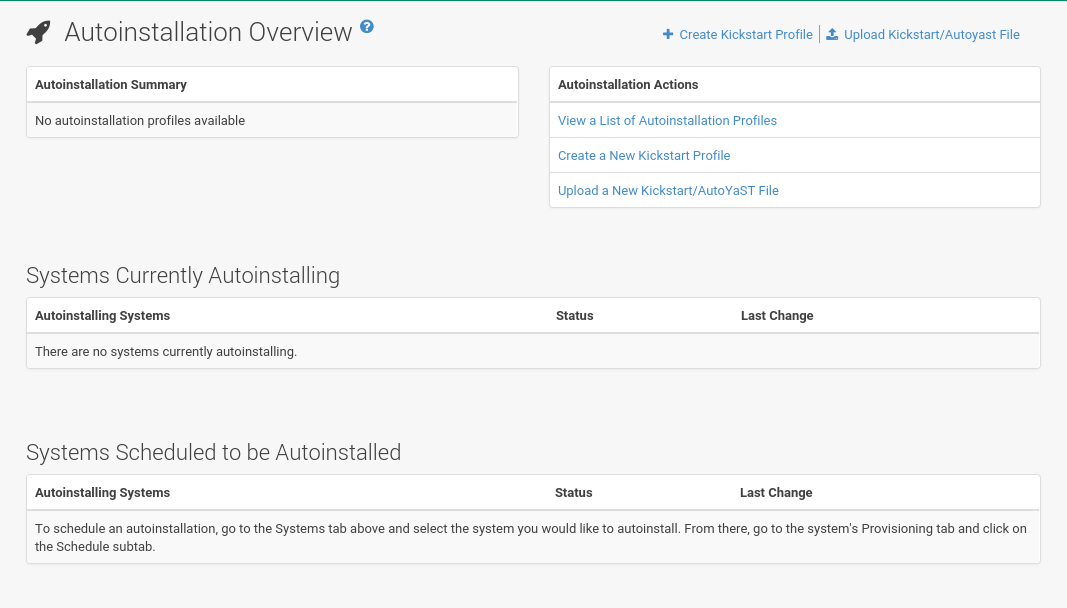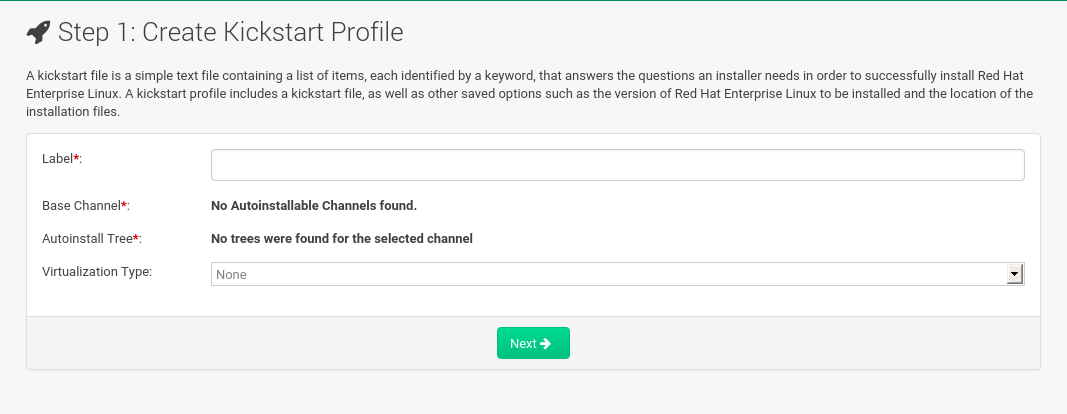Profiles (Kickstart and AutoYaST)
This page lists all profiles for your organization, shows whether these profiles are active, and specifies the distribution tree with which each profile is associated.

You can either create a Kickstart profile by clicking the Create Kickstart Profile link, upload or paste the contents of a new profile clicking the Upload Kickstart/Autoyast File, or edit an existing Kickstart profile by clicking the name of the profile.
Note, you can only update AutoYaST profiles using the upload button.
You can also view AutoYaST profiles in the edit box or change the virtualization type using the selection list.
Create a Kickstart Profile
Click on the Create Kickstart Profile link from the page to start the wizard that populates the base values needed for a Kickstart profile.

-
On the first line, enter a Kickstart profile label. This label cannot contain spaces, so use dashes (
-) or underscores (\_) as separators. -
Select a
Base Channelfor this profile, which consists of packages based on a specific architecture and Red Hat Enterprise Linux release.Creating Base ChannelBase channels are only available if a suitable distribution is created first. For creating distributions, see reference:systems/autoinst-distributions.adoc -
Select an
Kickstartable Treefor this profile. TheKickstartable Treedrop-down menu is only populated if one or more distributions have been created for the selected base channel (see reference:systems/autoinst-distributions.adoc). -
Instead of selecting a specific tree, you can also check the box
Always use the newest Tree for this base channel. This setting lets SUSE Manager automatically pick the latest tree that is associated with the specified base channels. If you add new trees later, SUSE Manager will always keep the most recently created or modified. -
Select the
Virtualization Typefrom the drop-down menu.If you do not intend to use the Kickstart profile to create virtual guest systems, you can leave the drop-down at the default Nonechoice. -
On the second page, select (or enter) the location of the Kickstart tree.
-
On the third page, select a root password for the system.
Depending on your base channel, your newly created Kickstart profile might be subscribed to a channel that is missing required packages.
For Kickstart to work properly, the following packages should be present in its base channel: pyOpenSSL, rhnlib, libxml2-python, and spacewalk-koan and associated packages.
To resolve this issue:
-
Make sure that the Tools software channel for the Kickstart profile’s base channel is available to your organization. If it is not, you must request entitlements for the Tools software channel from the SUSE Manager administrator.
-
Make sure that the Tools software channel for this Kickstart profile’s base channel is available to your SUSE Manager as a child channel.
-
Make sure that
rhn-kickstartand associated packages corresponding to this Kickstart are available in the Tools child channel.
The final stage of the wizard presents the tab. On this tab and the other subtabs, nearly every option for the new Kickstart profile can be customized.
Once created, you can access the Kickstart profile by downloading it from the Autoinstallation Details page by clicking the Autoinstallation File subtab and clicking the Download Autoinstallation File link.
If the Kickstart file is not managed by SUSE Manager, you can access it via the following URL:
http://`my.manager.server`/ks/dist/ks-rhel-`ARCH`-`VARIANT`-`VERSION`
In the above example, ARCH is the architecture of the Kickstart file, VARIANT is either client or server, and VERSION is the release of Red Hat Enterprise Linux associated with the Kickstart file.